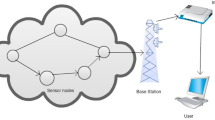Abstract
Wireless sensor networks enable a variety of application scenarios due to their flexibility, the wide range of hardware solutions, as well as their simplicity. However, new challenges arise that make applications viable, such as power consumption, robust communication, limited storage and processing. One of the main elements among communication and power consumption optimization aspects is related to the protocol stack and especially the medium access layer, due to the nature of the wireless environment. Thus, this article proposes a multi-channel mechanism for asynchronous receiver-initiated MAC for low-power WSN. The proposed protocol reduces energy consumption due to message contention and idle listening through an initial recognition mechanism and an efficient multichannel mechanism based on knowledge of the best channel in each node of the network. For validation of the protocol, evaluations were made for consumption, latency and rate of delivery of the network in a web application, comparing the multichannel asynchronous protocol to the synchronous protocol. The results show that the synchronous protocol presents slight superiority in communication performance, whereas the asynchronous protocol presents lower consumption.











Similar content being viewed by others
Notes
The request message has 15 bytes. The first 9 bytes are the IEEE802.15.4e message header. The CMD field indicates that it is a Livelist command (0x2E). The BC and chRank fields indicate the current best channel and its transmitter rank.
References
Palattella, M. R., Accettura, N., Vilajosana, X., Watteyne, T. Grieco, L. A., Boggia, G., & Dohler, M. (2012). Standardized protocol stack for the internet of (important) things. In IEEE communications surveys and tutorials.
Fafoutis, X., Di Mauro, A., Vithanage, M. D., & Dragoni, N. (2015). Receiver-initiated medium access control protocols for wireless sensor networks. Computer Networks, 76(Supplement C), 55–74.
Marques, B., & Ricardo, M. (2017). Energy-efficient node selection in application-driven wsn. Wireless Networks, 23(3), 889–918.
IEEE. (2012). Ieee802.15.4e- standard for local and metropolitan area networks–part 15.4: Low-rate wireless personal area networks (LR-WPANs) amendment 1: MAC sublayer. http://standards.ieee.org/findstds/standard/802.15.4e-2012.html.
Dutta, P., Dawson-Haggerty, S., Chen, Y., Liang, C.-J. M., & Terzis, A. (2012). A-MAC: A versatile and efficient receiver-initiated link layer for low-power wireless. ACM Transactions on Sensor Networks, 8(4), 301–3029.
Khalil, M. I., Hossain, M. A., & Ahmed, I. (2017). Duri-MAC: A dual channel receiver initiated MAC protocol for wireless sensor network (wsn). In 2017 international conference on electrical, computer and communication engineering (ECCE) (pp. 577–582).
Fernandes, R. F., de Almeida, M. B., & Brandão, D. (2018). An energy efficient receiver-initiated MAC protocol for low-power wsn. Wireless Personal Communications, 100(4), 1517–1536.
Ye, W., Heidemann, J., & Estrin, D. (2004). Medium access control with coordinated adaptive sleeping for wireless sensor networks. IEEE/ACM Transactions on Networking, 12(3), 493–506. cited By 2055.
Song, W.-Z., Huang, R., Shirazi, B., & LaHusen, R. (2009). Treemac: Localized tdma MAC protocol for real-time high-data-rate sensor networks. Pervasive and Mobile Computing, 5(6), 750–765. PerCom 2009.
So J., & Vaidya, N. H. (2004). Multi-channel MAC for ad hoc networks: Handling multi-channel hidden terminals using a single transceiver. In Proceedings of the 5th ACM international symposium on mobile Ad Hoc networking and computing, MobiHoc ’04 (pp. 222–233), New York, NY, USA, ACM.
Kim, Y., Shin, H., & Cha, H.. (2008). Y-mac: An energy-efficient multi-channel MAC protocol for dense wireless sensor networks. In Proceedings of the 7th international conference on information processing in sensor networks, IPSN ’08 (pp. 53–63), Washington, DC, USA, IEEE Computer Society.
Duquennoy, S., Al Nahas, B., Landsiedel, O., & Watteyne, T. (2015). Orchestra: Robust mesh networks through autonomously scheduled tsch. In Proceedings of the 13th ACM conference on embedded networked sensor systems, SenSys ’15 (pp. 337–350), New York, NY, USA, ACM.
Kim, T., Kim, I. H., Sun, Y., & Jin, Z. (2015). Physical layer and medium access control design in energy efficient sensor networks: An overview. IEEE Transactions on Industrial Informatics, 11(1), 2–15.
AlSkaif, T., Bellalta, B., Zapata, M. G., & Barcelo Ordinas, J. M. (2017). Energy efficiency of MAC protocols in low data rate wireless multimedia sensor networks: A comparative study. Ad Hoc Networks, 56, 141–157.
Beaudaux, J., Gallais, A., Montavont, J., Noel, T., Roth, D., & Valentin, E. (2014). Thorough empirical analysis of x-MAC over a large scale internet of things testbed. IEEE Sensors Journal, 14(2), 383–392.
Gaddour, O., & Koubâa, A. (2012). Rpl in a nutshell: A survey. Computer Networks, 56(14), 3163–3178.
Kim, H., Ko, J., Culler, D. E., & Paek, J. (2017). Challenging the ipv6 routing protocol for low-power and lossy networks (rpl): A survey. IEEE Communications Surveys Tutorials, 19(4), 2502–2525.
OpenWSN. Openwsn protocol stack. https://openwsn.atlassian.net. (Accessed 09 August 2019).
Author information
Authors and Affiliations
Corresponding author
Additional information
Publisher's Note
Springer Nature remains neutral with regard to jurisdictional claims in published maps and institutional affiliations.
Rights and permissions
About this article
Cite this article
Fernandes, R.F., de Almeida, M.B. & Brandão, D. Performance Evaluation of Asynchronous Multi-channel MAC Protocol for WSN. Wireless Pers Commun 113, 1115–1133 (2020). https://doi.org/10.1007/s11277-020-07270-w
Published:
Issue Date:
DOI: https://doi.org/10.1007/s11277-020-07270-w




